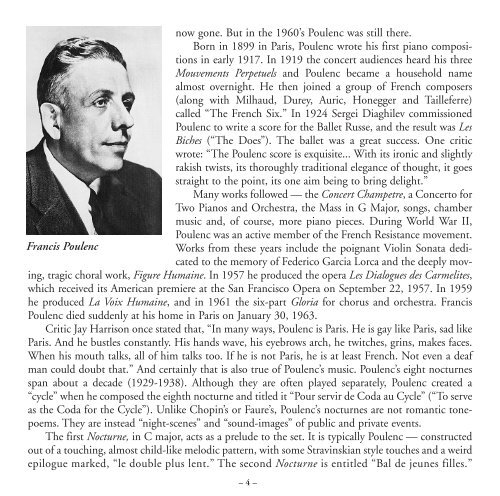Ralph Votapek - Ivory Classics
Ralph Votapek - Ivory Classics
Ralph Votapek - Ivory Classics
Create successful ePaper yourself
Turn your PDF publications into a flip-book with our unique Google optimized e-Paper software.
now gone. But in the 1960’s Poulenc was still there.<br />
Born in 1899 in Paris, Poulenc wrote his first piano compositions<br />
in early 1917. In 1919 the concert audiences heard his three<br />
Mouvements Perpetuels and Poulenc became a household name<br />
almost overnight. He then joined a group of French composers<br />
(along with Milhaud, Durey, Auric, Honegger and Tailleferre)<br />
called “The French Six.” In 1924 Sergei Diaghilev commissioned<br />
Poulenc to write a score for the Ballet Russe, and the result was Les<br />
Biches (“The Does”). The ballet was a great success. One critic<br />
wrote: “The Poulenc score is exquisite... With its ironic and slightly<br />
rakish twists, its thoroughly traditional elegance of thought, it goes<br />
straight to the point, its one aim being to bring delight.”<br />
Many works followed — the Concert Champetre, a Concerto for<br />
Two Pianos and Orchestra, the Mass in G Major, songs, chamber<br />
music and, of course, more piano pieces. During World War II,<br />
Poulenc was an active member of the French Resistance movement.<br />
Francis Poulenc<br />
Works from these years include the poignant Violin Sonata dedicated<br />
to the memory of Federico Garcia Lorca and the deeply moving,<br />
tragic choral work, Figure Humaine. In 1957 he produced the opera Les Dialogues des Carmelites,<br />
which received its American premiere at the San Francisco Opera on September 22, 1957. In 1959<br />
he produced La Voix Humaine, and in 1961 the six-part Gloria for chorus and orchestra. Francis<br />
Poulenc died suddenly at his home in Paris on January 30, 1963.<br />
Critic Jay Harrison once stated that, “In many ways, Poulenc is Paris. He is gay like Paris, sad like<br />
Paris. And he bustles constantly. His hands wave, his eyebrows arch, he twitches, grins, makes faces.<br />
When his mouth talks, all of him talks too. If he is not Paris, he is at least French. Not even a deaf<br />
man could doubt that.” And certainly that is also true of Poulenc’s music. Poulenc’s eight nocturnes<br />
span about a decade (1929-1938). Although they are often played separately, Poulenc created a<br />
“cycle” when he composed the eighth nocturne and titled it “Pour servir de Coda au Cycle” (“To serve<br />
as the Coda for the Cycle”). Unlike Chopin’s or Faure’s, Poulenc’s nocturnes are not romantic tonepoems.<br />
They are instead “night-scenes” and “sound-images” of public and private events.<br />
The first Nocturne, in C major, acts as a prelude to the set. It is typically Poulenc — constructed<br />
out of a touching, almost child-like melodic pattern, with some Stravinskian style touches and a weird<br />
epilogue marked, “le double plus lent.” The second Nocturne is entitled “Bal de jeunes filles.”<br />
– 4 –














